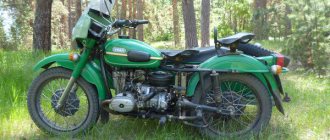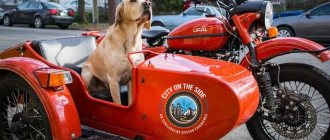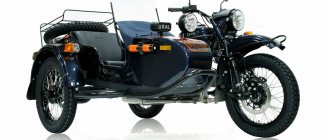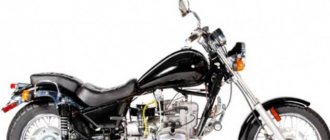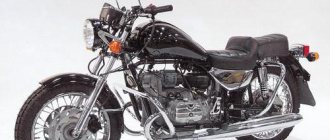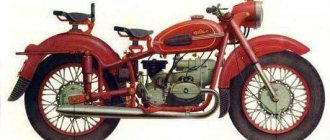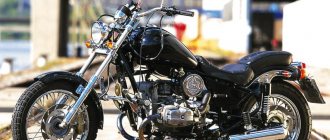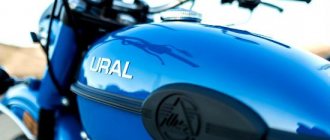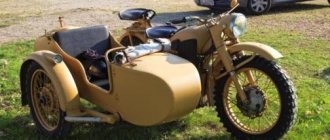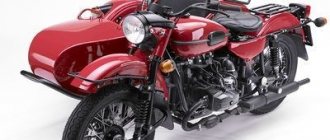At the end of the 30s of the 20th century, a meeting was held at the People's Commissariat of Defense of the USSR, the main topic of which was the analysis of new models of military equipment, and the prospects for adopting the best of them into service with the Red Army. One of the types of equipment that the Red Army urgently needed was an army motorcycle. After analyzing the samples, the best motorcycle was the German company BMW - R71.
By that time, it had already been in service with the Wehrmacht for several years. It was decided to use this car as the basis for a new motorcycle. The development of the domestic version of the R71, designated M72, took several years. Therefore, mass production of the domestic motorcycle began shortly before the war - in the spring of 1941. Production was mastered at the Moscow Motorcycle Plant (MMZ).
But due to the rapid German advance on Moscow, by the end of October 1941 the plant was evacuated to the city of Irbit. The territory of a former brewery was provided as a site for the plant. The new enterprise became known as IMZ (Irbit Motorcycle Plant). Serial production of the M72 IMZ began at the end of 1941.
The M72 was initially equipped with a lower-valve engine, which even at the time of the creation of the machine had few reserves for improvement. This circumstance prompted IMZ designers to create a new overhead valve engine. This device went into production in 1957. A transitional model motorcycle equipped with such an engine was designated M61. Motorcycles M72M and M61 were produced in parallel until 1960.
Since 1961, simultaneously with the assembly of the now old M61 model, the production of the new Ural M62 model began. The motorcycle came complete with a sidecar. This stroller was single and equipped with a luggage compartment located behind the back of the seat. The stroller was attached to the motorcycle frame using collet joints and braces at four points. The stroller wheel had a lever suspension with a shock absorber. Suspension travel is up to 120 mm. The spare wheel was mounted on the luggage compartment lid of the stroller. The general appearance of the Ural M62 motorcycle can be seen in the photo below.
M62 engine
The Ural M62 motorcycle was equipped with a four-stroke, carburetor, two-cylinder engine with an opposed cylinder arrangement. The engine had an overhead valve timing system and traditional air cooling. The cylinder diameter was 78 mm, the piston stroke was 68 mm, and the engine cylinder displacement was 649 cc.
Thanks to improvements in design and an increase in the compression ratio to 6.2, the power of the M62 engine has increased. Compared to its predecessor, it has increased by 2 liters. With. and amounted to 20.6 kW (28 hp). Maximum power was achieved at 4,800-5,200 crankshaft rpm. Torque also increased, which was quite good for those times at 41.8 N/m at 3,500 rpm.
The engine cylinders were made by casting from high-alloy cast iron; the right and left cylinders were completely interchangeable. The engine was equipped with aluminum cylinder heads and two overhead valves per cylinder. The combustion chambers are hemispherical. The valves were suspended on two spiral springs.
This solution, together with metal-ceramic valve guides in the cylinder heads, ensured the operation of the valves without jamming and rapid wear, and also significantly increased their operational reliability. Due to the increased power, the M62 engine received reinforced pistons. Each piston had four piston rings - two compression rings and two oil scraper rings. The upper compression ring had porous chrome plating, which ensured reliable lubrication of the cylinder mirror and, accordingly, increased mileage before major repairs.
The more advanced engine had more liter power, which also made it possible to increase the dynamic properties of the motorcycle. It should be noted that the reduction in engine displacement and the transition to an overhead valve timing system significantly reduced the metal consumption of the structure, which in turn reduced the weight of the motorcycle. According to various sources, the maximum speed reached 95-100 km/h (with a sidecar), with control fuel consumption - 5.8-6 l/100 km (at a speed of 75% of the maximum).
Chassis
The M62 is equipped with a telescopic fork with hydraulic shock absorbers and internal springs. The difference between this fork and the M72 fork is a different spring arrangement and a slightly different design of the fork leg shock absorber.
Each shock absorber consists of a housing, a rod 11 with a piston 17, a lower guide and a housing nut. The shock absorber body is placed inside the fork leg tube. Holes for oil passage are drilled in the lower part of the housing.
The piston has a disc-shaped shape. The edges of the piston fit tightly to the inner surface of the shock absorber body.
The shock absorber tube nut is a cup with a calibrated hole in the center. A rubber buffer is installed inside the nut to protect the piston from sudden impacts.
The shock absorber body moves along with the tips of the fork stays, and the rod and the lower guide rod with the piston are stationary
.
A fork spring is screwed onto the spiral groove of the shock absorber body nut, the upper end of which is screwed onto the spring tip mounted on the rod and clamped between two nuts.
When assembling the front fork, you must ensure that there is a gap of 0.2-0.5 mm between the upper tip of the spring and the nut locking the tightening nut of the fork leg tube, ensuring free rotation of the tightening nut with the rod.
M 62 front fork diagram
The rear suspension of the chassis consists of two identical units, does not have hydraulic shock absorbers and is installed in the rear frame brackets.
The right bracket is made in one piece with the rear gear housing cover, while the left one is a separate part. Both brackets have the ability to move on steel rods.
The suspension springs are screwed onto the suspension brackets and onto the spring tip and covered with protective covers. The lower parts of the springs are connected to the wheel axle, and the upper parts are connected to the motorcycle frame.
Rear wheel suspension diagram.
Wheels
The M 62 is equipped with wheels with steel or aluminum hubs.
Both types of wheels are interchangeable. To ensure interchangeability of motorcycle and sidecar wheels, an adapter sleeve with an outer diameter of 25 mm is installed in the hub.
The wheel with a steel hub has 40 spokes: 20 long with curved heads and 20 short straight. In a wheel with an aluminum hub, all spokes are the same length with curved heads.
The stroller has a torsion bar suspension.
Return to contents — ↑
M62 engine power and lubrication system
So, we continue to consider the characteristics of the Ural M62. Its power system included two K-38 carburetors, mesh fuel filters in the gas tap sump and in the neck of the gas tank. The fuel tank capacity was 22 liters. The air filter is combined, inertial and contact-oil with two-stage cleaning. The air filter filling capacity is 0.2 l.
The lubrication system is standard, combined - under pressure from the oil pump and splashing. The engine crankcase capacity is 2 liters.
History of the development of the model design
The Ural M 62 motorcycle, 650 cm cubed, was created in 1961 by the Irbit Motorcycle Plant on the basis of the M 72M motorcycle.
After the Irbit plant created a new forced overhead valve engine and began installing it on the M 72 motorcycle, a transitional model appeared - the M 61.
The M62 motorcycle is a modernized model of the M 61 and differs from it in the design of the power transmission, chassis and ignition system devices. The main technical parameters of the engine remained unchanged.
The engines are overhead valve and were manufactured on the basis of the M 72M engine, therefore only their distinctive features are described in comparison with the design of the M 72M engine.
The crank with connecting rods is an integral unit, which differs from the corresponding unit of the M 72M engine in the length of the connecting rod and the distance from the axis of the axle to the axis of the crank pin.
A second oil scraper ring is installed on the lower part of the piston skirt.
The cylinders are interchangeable and in the upper part have four holes for the head mounting studs and two holes into which the pusher rod tubes are pressed.
To drain oil from the valve box into the crankcase, there is a tube passing through the cylinder ribs.
Diagram of the gas distribution mechanism of the M 62 engine.
The gas distribution mechanism of the described engine is an overhead valve mechanism, which is its fundamental difference from the M 72M engine.
The valve disc diameter is 35mm, the stem diameter is 7.5mm and the overall valve length is 91mm. The valves move in guides pressed into the body of the cylinder head. The gap between the bushing and the valve stem is 0.05-0.1 mm.
The camshaft has four camshafts, which differ from the cams of the M72M engine shaft in their shape and location, which makes the camshafts not interchangeable.
Tips with a hemispherical recess are pressed into the body of the pushers.
The thermal gap (0.1 mm) between the valve stem and the rocker arm is adjusted with the valve box cover removed.
Lubrication system
Valves and rocker arms are splash lubricated. Through holes located at the end of the pushrod guide bushings and the rod casing, oil enters the cylinder heads and is sprayed there by the valve springs.
Supply system
The M 61 engine has two K-52 carburetors, and the M 62 engine has two K-38 carburetors. Two K-37 carburetors can be installed on the M61 motorcycle engine.
Electrical equipment M62
The Ural M62 motorcycle was equipped with a 6-volt electrical system. The current sources were a 3MT-12 battery and a G-414 direct current generator with a power of 60 W (on the earliest versions of the G65), working in tandem with a relay-regulator PP-302. The ignition system included a model B-201 ignition coil and a PM-05 ignition chopper.
The breaker was equipped with a centrifugal ignition advancer. New components of the ignition system made it possible to automatically set the optimal engine operating mode, which improved the dynamic characteristics of the motorcycle while reducing fuel consumption.
Our days
The production of the Ural M62 motorcycle continued until 1965. Then it was replaced by a new model - M63. Today, Ural M62 motorcycles have become quite a rare machine, although you can still find examples in almost original condition. Such motorcycles are readily purchased by lovers of old motorcycles, both for restoration in a completely original form, and for creating retro choppers based on them.
Due to my line of work, I have to constantly monitor advertisements for the sale of all equipment and spare parts. I didn’t plan to buy this motorcycle, because... From domestic equipment I prefer lower valves (M72 and K750). For two years the ad was hanging on the drome and the thought of buying periodically came to me, especially since he had impeccable documents. The Ural was in very bad condition, I felt sorry for it. In general, I couldn’t stand it, I went and bought it. I didn’t even inspect it, they just loaded it into the car and took it to the workshop. Moreover, everything is already clear - everything is very bad...
Meet the Ural M-62, produced in 1962, green and worn out by life. He was born at a time when a personal car was the lot of very few people, and it was also very difficult for ordinary citizens to buy heavy motorcycles (they were distributed among collective farms, were registered with the military, ordinary people waited in line for years to buy). Back then, motorcycles were not toys and a fetish, a means of getting adrenaline and riding pleasure. They were workhorses, they transported hay and potatoes from the fields, they were hunted, plowed and exploited “by the tail and the mane”, but there were practically no cars. There was no talk of any comfort or fuel economy at all. It wasn’t just a motorcycle or a set of spare parts that came to me. This is a whole era, the spirit of the time. He was someone's joy and help, destinies were connected with him. Unfortunately, it was not possible to find out anything about the history of this specimen; the documents are of a new type and were purchased from a second-hand dealer, who said that he bought it from some grandfather.
I look at him and think, why? Why did I buy myself another headache, especially since I need to spend a lot of time on it, and money too. I wanted to build a retro motorcycle out of it, alone. All ideally painted and absolutely drivable, and of course for sale, because... It's cost effective for me. Despite the fact that I already have a similar one. Here is his photo
How wrong I was...)) The 70th anniversary of the Great Victory and the desire to travel with a sidecar, take the kids for rides, take part in the parade, encouraged me to put the motorcycle on the road in the form it is. It is in its original paint, even the Ural inscriptions on the tank are readable. Opening the engine showed that it needs to be shelved until better times. But on that shelf a new engine from a more recent Ural lay waiting in the wings. I completely disassembled the chassis, cleaned it, replaced worn parts, found missing ones, modified some things, made new wiring, laying it in the old and rusty cable channel. It was decided not to paint or polish anything at all, let it be as is. Surprisingly, good and strong metal shines under the shabby paint, there are not even any dents. Corrosion only ate through a small area on the cradle where moisture accumulated and stood. The result was an old and battered motorcycle. But this is only the first impression. All suspension, chassis, gearbox, brakes are ideal, new engine and gearbox (I’ll definitely fix the old one when I find all the spare parts). Started up, works like a clock. The sound is amazing, the idle is kept so low that you can count the crankshaft revolutions. It drives and brakes well. A steering friction damper helps keep the steering wheel steady on bad roads. Even the front brake easily skids when pressed hard. Among the goodies are titanium mufflers, which give a special timbre to the exhaust sound.
But I was wrong, I thought to travel only during the May holidays and then start the restoration process with subsequent sale. But I just didn’t get off it after the holidays. And in general I drove it all summer and autumn. I’m not going to restore it, much less sell it! It gave so many positive emotions and so many summer and riding impressions that few Japanese motorcycles are capable of this (my Japanese motorcycles were covered in dust while standing in the garage). We drove through forests, fields, thickets, and ravines. In the rain, in the heat, in the snow. To the store, for lunch, anywhere at all. Every day. And you don’t have to worry about painting, you can stand with your feet on any part of the motorcycle (linden color, for example, it’s convenient to assemble or break through thickets of young and not so young trees))). For a family holiday, absolutely ideal. You can put a lot of useful things in the stroller. I could travel several tens of kilometers in the evening. He never let me down (well, that’s more to my credit). Yes, there is no comfort, the rubber saddles hurt your butt, your arms get tired. But you can experience at least every day the indescribable sensations of transferring to a Japanese motorcycle (like for the first time), which rides, and the suspension... no SUSPENSION works))) So, standing in an iron garage on the outskirts of the city, this Ural was already preparing to depart into the world ferrous metal or sell for spare parts. But I definitely didn’t suspect that I was returning to a full Life, filled with human emotions and joys. And this is not a sad standing in a museum or in the garage of an elderly lover of rarities, carefully wiping the dust off it and shaking over every scratch. You can rest assured that I will let this Ural fuck itself, but if it breaks, I will fix it)). But it definitely won’t rot now, but will delight me, my family and friends for many years. Treasure old motorcycles, but don't forget, they need to run.
and a short video
Motorcycle Ural M-62
Ural M-62 is a Soviet heavy motorcycle with a sidecar. Produced by the Irbit Motorcycle Plant from 1961 to 1965. Since 1961, they began producing the M-62 model in parallel with the assembly of the previous M-61 model. The new motorcycle featured a new camshaft and an automatic ignition advance mechanism, thanks to which engine power increased by 2 hp. With. and amounted to 28 hp. The gearbox was also modernized - instead of cam gears, gear clutches were installed. The gearbox was unified with motorcycles from the Kyiv Motorcycle Plant (KMZ). In addition, the new model had increased suspension travel and changed the shape of the front fork housings.IMZ M-62 (1961-1965) - a heavy road motorcycle with a sidecar, which was a slightly modernized M-61. In addition to the updated appearance, the motorcycle received a modified engine that produces maximum power at 5200 rpm, new K-38 carburetors, automatic ignition timing, chain throttle and duralumin clutch and brake levers. The car has become 40 kg lighter (320 kg) and a little more maneuverable. The M-62 model can simply be called a legend of the Irbit plant. It differed from the previous ones in that it featured automatic ignition timing and lightweight duralumin control levers on the lever. This model of motorcycle is usually classified as a heavy-sized motorcycle, which is usually used with sidecars. The motorcycle engine is four-stroke, two-cylinder. The cylinders have an opposed arrangement. This model is characterized by the installation of a cardan transmission between the rear wheel and the gearbox. The cardan transmission has greater wear resistance and reliability. The frame of this motorcycle is spark plug. The maximum speed can reach up to 95 kilometers per hour. The engine displacement is 649 cc. Power 20.6 kW. Recommended carburetor K-38. The main drive is represented by a cardan and a pair of bevel gears. Voltage 6 Volts. These models are equipped with a system with a centrifugal automatic ignition advance. The cylinder diameter is 78 and the piston stroke is 68. The fuel tank capacity is 22 liters. Fuel consumption per 100 kilometers is 6 liters. The M-62 motorcycle reaches a maximum speed of 100 kilometers per hour. This model has drum brakes. The weight of the motorcycle is 340 kg. The distance between the wheel axles is 1100 mm. The motorcycle is large, heavy, and performs well in cases where you need to ride on uneven roads, gullies, and forests.
Dimensional dimensions, MMDLLIN 2420 Shirina 1650 EXTROUSE 1100 BAZ of the motorcycle (distance between the wheel axes), mm 1435. Rifting at full load and normal pressure in the tires, mm 125Koley, mm 1130maximal speed, km/h 95mas, kg 320maximal load, kg 255 medium operational fuel consumption per 100 km of track when driving in various road conditions with variable load, l 6 Engine Type: four-stroke, carburetor, two-cylinder with opposed cylinders, air cooling Displacement, cm3 649 Cylinder diameter, mm 78 piston stroke, mm 68 Compression ratio 6.2 Maximum power, hp . (kW) 28 (20.6) at 4200-4800 rpm Maximum torque, Nm (kgf m) 44 (4.5) Carburetor: K-38 Air cleaner: combined inertial contact-oil filter with two-stage cleaning Transmission Clutch: dry double-disc, driven discs with linings on both sides Cardan transmission: cardan shaft with an elastic coupling and a hinge on needle bearings Main gear: a pair of bevel wheels with spiral teeth, gear ratio - 4.62 Gearbox: four-speed, with gear ratios in 1, 2, 3, 4 gears 3.6; 2.28; 1.7; 1.3 respectively Electrical equipment Ignition system - battery Voltage, V 6 Rechargeable battery: 3MT-12 Generator: G-414 Relay-regulator: PP-31 Breaker-distributor: PM05 Ignition coil: B201 Chassis Frame: tubular double closed type Suspension front wheel: telescopic fork with double-acting hydraulic shock absorbers Rear wheel suspension: spring Front wheel travel, mm 80 Rear wheel travel, mm 60 Tire size, inch 3.75-19 Brakes: shoe, with friction linings on the front and rear wheels Filling volumes Fuel tank, l 22 Engine crankcase, l 2 Gearbox housing, l 0.8 Final drive housing, l 0.15 Air cleaner, l 0.2
Ural M-62 is a Soviet heavy motorcycle with a sidecar. Produced by Irbitsky Motorcycle) from 1961 to 1965.
Since 1961, they began producing the M-62 model in parallel with the assembly of the previous M-61 model. The new motorcycle featured a new camshaft and an automatic ignition advance mechanism, thanks to which engine power increased by 2 hp. With. and amounted to 28 hp. The gearbox was also modernized - instead of cam gears, gear clutches were installed. The gearbox was unified with motorcycles from the Kyiv Motorcycle Plant (KMZ). In addition, the new model has increased suspension travel and changed the shape of the front fork housings.
Transmission M62
Due to the increased torque characteristics, the clutch discs received a reinforcing coating made from the then new friction material KF-3. The new raw materials had high wear resistance combined with a high coefficient of friction.
The motorcycle received a completely new four-speed gearbox model 6204 with a fine-spline shift mechanism. The filling capacity of the gearbox housing is 0.8 liters. The new gearbox was largely freed from the defects of the M72 gearbox. The rear gear, traditional for IMZ motorcycles, has also undergone changes, consisting of a cardan shaft and a rear wheel gearbox.
The driveshaft connection became splined, and the crosspiece received needle bearings instead of bronze bushings. The final drive (MF) of the motorcycle consisted of a pair of bevel gears with a spiral tooth. The gear ratio is GP 4.62, the oil volume in the crankcase is 0.15 liters.
About the Ural M 62 motorcycle model
This Soviet heavy motorcycle was produced with a sidecar in 1961-1965.
Nevertheless, its high popularity continues to exist today (thanks to the presence of lovers of restoration and retro motorcycles). In 1961, mass production of bikes of the M-62 series was launched without abandoning the parallel production of the previous model (M-61 series). The new iron horse received a new camshaft, as well as an automatic ignition advance mechanism. It was thanks to the latter that the power of the iron horse increased to 28 horses. The modernization also affected the gearbox. The designers abandoned the cam clutch.
Now the gear version is used. The gearbox was unified with representatives of the Kyiv Motor Plant.
Ural M 62 motorcycles can be purchased in versions with increased suspension travel. In addition, in this model the shape of the housings in the front fork was changed.
M62 controls
To improve the driver's position, the geometry of the steering wheel was changed and the driver's saddle was equipped with a rubber damping element. In addition, new features include a double-cable throttle handle and new front brake and clutch levers. Other motorcycle control mechanisms have also become more convenient and reliable in operation.
Technical characteristics of Ural M62
| Maximum load | 255 kg |
| Weight (dry) | 340 kg |
| Length | 2 420 mm |
| Width | 1 650 mm |
| Height | 1,000 mm |
| Base, mm | 1,435 mm |
| Ground clearance | 125 mm |
| Track | 1 140 mm |
| Maximum speed | 95…100 km/h |
| Control fuel consumption | 5.8…6.0 l/100 km |
Notes
| Components | |||||||||||||||||||||||||||||||||
Engine
| |||||||||||||||||||||||||||||||||
| Clutch | dry double disc | ||||||||||||||||||||||||||||||||
| checkpoint |
| ||||||||||||||||||||||||||||||||
| Drive unit | cardan shaft | ||||||||||||||||||||||||||||||||
| Fuel supply | by gravity | ||||||||||||||||||||||||||||||||
| Front tire | |||||||||||||||||||||||||||||||||
| Rear tire | |||||||||||||||||||||||||||||||||
| Specifications | |||||||||||||||||||||||||||||||||
| Tank capacity | |||||||||||||||||||||||||||||||||
| Dimensions | |||||||||||||||||||||||||||||||||
| Length, mm | |||||||||||||||||||||||||||||||||
| Width, mm | |||||||||||||||||||||||||||||||||
| Height, mm | |||||||||||||||||||||||||||||||||
| Motorcycle base, mm | |||||||||||||||||||||||||||||||||
| Ground clearance, mm | |||||||||||||||||||||||||||||||||
